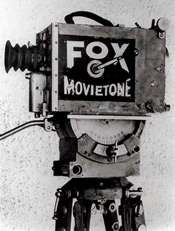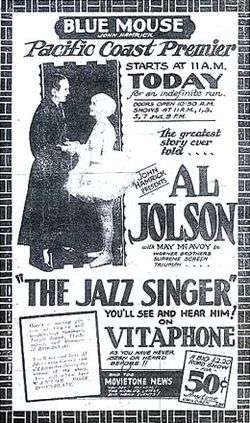Movietone News
Movietone News is a newsreel that ran from 1928 to 1963 in the United States. Under the name British Movietone News, it also ran in the United Kingdom from 1929 to 1979, In France also produced by Fox-Europa, in Australia and New Zealand until 1970, and Germany as Fox Tönende Wochenschau.[1]
History

Movietone News evolved from an earlier newsreel established by Fox Films called Fox News which was founded in 1919. It produced silent newsreels. When Fox entered talkies in 1928 with Mother Knows Best, the name Fox Movietone was applied to Fox's sound productions.
In the U.S. as Fox Movietone News it produced cinema, sound newsreels from 1928 to 1963, and from 1929 to 1979 in the UK (for much of that time as British Movietone News), as well as 1929 to 1975 in Australia. One of the earliest in the series featured George Bernard Shaw Talks to Movietone News, released on June 25, 1928.
One of the known early producers of these newsreels was Abraham Harrison also known as Harry, father of notable black and white photographer Dody Weston Thompson who also found a brief career in film making.
An early conductor of the Movietone News orchestra was Harry Lauder II, nephew of entertainer Sir Harry Lauder, who was contracted by the company for eighteen months before William Fox took him to his Hollywood studio. Sir Harry Lauder also appeared in test sound films made at the Fox Studios in New York City during the winter-spring of 1927.

One installment, Fox Grandeur News, was released on May 26, 1929, in Fox's short-lived widescreen process Grandeur, and shown before the feature film Fox Movietone Follies of 1929.
Hearst Metrotone News initially leased the Case Research Lab patents from William Fox for its sound newsreels. Each of these studios used this system of recording sound film for news items because it was an easily transported single-system of sound-on-film recording.
Fox's first use of recording a news event was on May 20, 1927: Charles Lindbergh's take-off from Roosevelt Field for his historic solo flight across the Atlantic Ocean was filmed with sound and shown in a New York theater that same night, inspiring Fox to create Movietone News. A regular narrator of the newsreels was broadcaster/journalist Lowell Thomas.
After Fox Films merged with 20th Century Pictures in 1935 to form 20th Century-Fox, the name of Fox Movietone News was shortened to Movietone News.
In Australia, Movietone and Cinesound were competitors for newsreel coverage, but have now combined under the Movietone News name.
Status and licensing
The University of South Carolina Moving Image Research Collections[2] has a portion of the Fox Movietone newsreel collection. The rest of it is owned and managed by the Fox Film Corporation's corporate successor (and namesake), Fox News Channel. During its early years, Fox News Channel had a weekend show which played the newsreels.
Licensing for Fox Movietone newsreels owned by the University of South Carolina is handled by the Moving Image Research Collections while licensing for Fox Movietone News is still owned by Fox Corporation and handled by Fox News Channel. British Movietone is owned separately by the films' successor-in-interest, operating under the name British Movietonews Ltd. British Movietone is represented by AP Archive in the UK. In the United States, licensing of those newsreels is handled by ABC News.
In September 2016, it was announced that the British Movietone archive had been acquired by Associated Press.[3][4][5]
Archive
The Academy Film Archive houses the 20th Century Fox Movietone Shorts and Documentaries Series Collection.[6]
In 2015, British Movietone and Associated Press's archival footage were released on YouTube.[7][8]
See also
- Newsreels
- List of online video archives
- Movietone sound system sound-on-film system introduced by Fox Film Corporation in 1927
- Movietone Records the budget subsidiary of 20th Century Fox's record division
References
- Baechlin, Peter; Walter-Strauss, Maurice (1952). Newsreels across the world (PDF). UNESCO Paris.
- http://library.sc.edu/p/collections/mirc]
- "AP acquires historic British Movietone archive". Associated Press.
- "Subscribe to read". Financial Times.
- Sweney, Mark (27 September 2016). "AP acquires British Movietone archive" – via www.theguardian.com.
- "20th Century Fox Movietone Shorts and Documentaries Series Collection". Academy Film Archive.
- "AP makes one million minutes of historical footage available on YouTube". Associated Press.
- Victor, Daniel (22 July 2015). "YouTube's Historical Footage Expands, Both Serious and Silly" – via www.nytimes.com.
External links
- Fox Movietone News web site
- official British Movietone YouTube channel, archival footage
- Extensive index and clips from University of South Carolina
- Cinesound Movietone web site
- George Bernard Shaw Talks to Movietone News (1928) at IMDB
- Two Movietone newsreels from archive.org
- Extensive index and clips from University of South Carolina
- Clips from University of South Carolina
- Movietone Records information